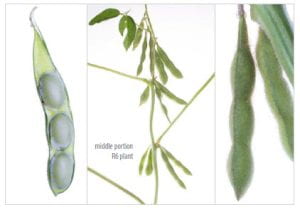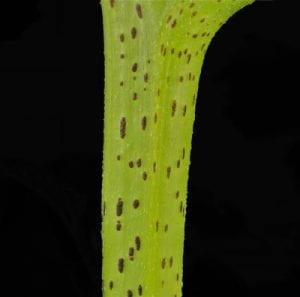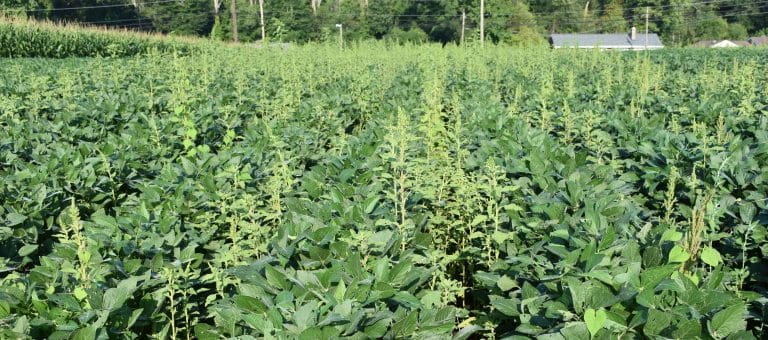
Alfalfa
 2nd cutting is well underway. Potato leafhoppers are very active. If you haven’t cut yet, continue to monitor, where damage is increasing, cut as soon as weather permits.
2nd cutting is well underway. Potato leafhoppers are very active. If you haven’t cut yet, continue to monitor, where damage is increasing, cut as soon as weather permits.
Click here for alfalfa insect scouting calendar
Click here for more information on Potato Leafhopper
Corn
 Our corn growth varies greatly throughout the county. Some fields are beginning to tassel and some field are at V8.
Our corn growth varies greatly throughout the county. Some fields are beginning to tassel and some field are at V8.
V12 to V13 – Six weeks after the plant emerges, V12 begins. Moisture or nutrient deficiencies may reduce the potential number of seeds, as well as the ear size, seriously. These two components of yield have key development during the period from V10 to V17. The length of time for the plant to develop through these stages affects harvestable yield.
Early maturity hybrids normally progress through these stages in less time and have smaller ears than later hybrids. Higher plant populations are needed for earlier hybrids to produce grain yield similar to normal-maturity hybrids in the adapted region. Cultivation of plants at this time will destroy some of the plant roots. Brace roots are developing from the fifth node and the first above-ground node.
V14 to V15 – Seven weeks after the plant emerges, V14 begins. The corn plant at V15 is only 12 to 15 days (around one to five V stages) away from R1 (silking). This vegetative stage is the most critical period of seed yield determination. The number of ovules that develop silks, and thus the number of kernels, is being determined. Any nutrient or moisture deficiency or injury (such as hail or insects) may seriously reduce the number of kernels that develop.
The tassel is near full size but not visible from the top of the leaf sheaths. Silks are just beginning to grow from the upper ears. Upper-ear shoot development has surpassed that of lower ear shoots. A new leaf stage can occur every one to two days.
Brace roots from the sixth leaf node are developing, and the permanent roots have continued to elongate and proliferate, eventually reaching a depth of about 5 to 8 feet and spreading several feet in all directions. In some hybrids, brace roots also will develop from the eighth and ninth leaf nodes or even higher. Some corn plants in North Dakota may only develop 16 leaves.
Critical corn growth stages
Table 5. Postemergence Herbicides in Corn – Grasses
Table 6. Postemergence Herbicides in Corn – Broadleaves
Soybeans
 Soybeans are starting to look a little bit better, however, there are still a lot of “yellow” beans throughout the county. Two possible reasons are Yellow Flash and Soybean Cyst Nematode. Other possibilities are seedling diseases and water-logged roots, more information on these topics next week.
Soybeans are starting to look a little bit better, however, there are still a lot of “yellow” beans throughout the county. Two possible reasons are Yellow Flash and Soybean Cyst Nematode. Other possibilities are seedling diseases and water-logged roots, more information on these topics next week.
After planting, the second biggest challenge we face is timely weed control. If you haven’t already made a postemergence application, it might be time to check your fields. Most beans (and weeds) are at stage that might warrant an application. The links below will contain OSU Herbicide rating for postemergence applications.
Soybean Postemergence Weed Control – Grasses
Soybean Postemergence Weed Control – Broadleaves
Soybean Growth & Development – R1: Beginning Bloom

- Open flower at any node on the main stem
- Flowering begins at 3rd to 6th node (V6 to V10 stage)
- Flowering period is 3 to 4 weeks
–Begins ~6 to 8 weeks after emergence
– Peaks R2 to R3; ends ~R5
- Vertical root growth rates increase rapidly
– As much as 1.3 to 3.2 in/day
Wheat
 Wheat harvest has come to an end and most of the straw is in the barn. From what I hear, wheat yields were pretty good with little to no disease issues.
Wheat harvest has come to an end and most of the straw is in the barn. From what I hear, wheat yields were pretty good with little to no disease issues.
If you removed the straw, remember to account for the additional fertilizer removal when planning for fertilizer needs next year. Read more here.
Double crop beans have been, or are being planted now. Click here for the Double Crop Soybean Production Guidelines from Dr. Laura Lindsey.
Misc. – Something you don’t see everyday.
I can honestly say that I have never seen one of these before! Click on the picture to see the video. If you know what it is, put your answer in the comment section. Be sure to check back next week for the answer!
… AND THE ANSWER IS – Horsehair Worm
https://entomology.ca.uky.edu/ef613

County Rainfall Update

Corn Water Requirements
Soybean Water Requirements










 Stem: Mature stems are green, 1-4 ft. tall, highly branched, hairy, and flecked with maroon to black spots. Ridges are present on the stem. Upright hairs cause leaves to feel abrasive and gritty.
Stem: Mature stems are green, 1-4 ft. tall, highly branched, hairy, and flecked with maroon to black spots. Ridges are present on the stem. Upright hairs cause leaves to feel abrasive and gritty.
 Flower/Seedhead: Inconspicuous, greenish in color, arising from the area between the leaf petioles and the stems (axillary flowers) and at the ends of the erect stems (terminal flowers).
Flower/Seedhead: Inconspicuous, greenish in color, arising from the area between the leaf petioles and the stems (axillary flowers) and at the ends of the erect stems (terminal flowers).
 Disease pressure throughout the county continues to be very low. At this stage of growth, with little to no disease pressure, and new crop corn under $5 can we justify at least $25 per acre for a fungicide application?
Disease pressure throughout the county continues to be very low. At this stage of growth, with little to no disease pressure, and new crop corn under $5 can we justify at least $25 per acre for a fungicide application?


 It’s that time of year when weeds are beginning to show their ugly heads above the soybean canopy in many fields. During your scouting, if you find Palmer Amaranth or Waterhemp you should do whatever you can to prevent these devastating weeds from going to seed, including removing the entire plant from the field.
It’s that time of year when weeds are beginning to show their ugly heads above the soybean canopy in many fields. During your scouting, if you find Palmer Amaranth or Waterhemp you should do whatever you can to prevent these devastating weeds from going to seed, including removing the entire plant from the field.

 Pigweed has hair the others do not. Rub the stem and leaves checking for a “rough” texture. Palmer and waterhemp will be smooth.
Pigweed has hair the others do not. Rub the stem and leaves checking for a “rough” texture. Palmer and waterhemp will be smooth.
 the part of the plant that connects the leaf to the stem. The petiole on palmer plant is as long or longer than the leaf. Pigweed and waterhemp have much shorter petioles (often less than 1/2 the length of the leaf).
the part of the plant that connects the leaf to the stem. The petiole on palmer plant is as long or longer than the leaf. Pigweed and waterhemp have much shorter petioles (often less than 1/2 the length of the leaf).



 Seedlings: Stems below the cotyledons (hypocotyls) are without hairs (glabrous), and are often red in color. Cotyledons are narrow and green to reddish in color on the upper surface. Lower surfaces of cotyledons have a reddish tint. First true leaves are alternate, ovate in shape, and are slightly notched at the tip of the leaf blade
Seedlings: Stems below the cotyledons (hypocotyls) are without hairs (glabrous), and are often red in color. Cotyledons are narrow and green to reddish in color on the upper surface. Lower surfaces of cotyledons have a reddish tint. First true leaves are alternate, ovate in shape, and are slightly notched at the tip of the leaf blade Stem:
Stem: Leaves:
Leaves: Flower/Seedhead:
Flower/Seedhead:
 Seedling leaves are oar shaped, first true leaves appear lance-shaped and have a minute notch at the tip of the leaf.
Seedling leaves are oar shaped, first true leaves appear lance-shaped and have a minute notch at the tip of the leaf.



 Seedlings: Hairy, often red in color, especially near the base. Cotyledons are narrow and green to reddish in color on the upper surface. Lower surfaces of cotyledons have a reddish tint. First true leaves are alternate, ovate in shape, and are slightly notched at the tip of the leaf blade (apex). Hairs may occur on the leaf margins and along veins, especially along the lower leaf surfaces.
Seedlings: Hairy, often red in color, especially near the base. Cotyledons are narrow and green to reddish in color on the upper surface. Lower surfaces of cotyledons have a reddish tint. First true leaves are alternate, ovate in shape, and are slightly notched at the tip of the leaf blade (apex). Hairs may occur on the leaf margins and along veins, especially along the lower leaf surfaces. Stem: Stout, erect, branched, and reaching 6 1/2 feet in height. Stems usually have short hairs, especially near the upper portions of the plant.
Stem: Stout, erect, branched, and reaching 6 1/2 feet in height. Stems usually have short hairs, especially near the upper portions of the plant. Leaves: Alternate, ovate in outline, with petioles that reach 1/2 inch in length. Leaves have wavy margins and hairs that occur along the veins of the lower leaf surfaces.
Leaves: Alternate, ovate in outline, with petioles that reach 1/2 inch in length. Leaves have wavy margins and hairs that occur along the veins of the lower leaf surfaces.
 Preharvest intervals indicate the amount of time that must elapse between the herbicide application and crop harvest. Failure to observe the preharvest interval may result in herbicide residue levels in the harvested portion of the crop in excess of established limits. Also, livestock grazing or foraging treated soybean is not allowed on the labels of many postemergence soybean herbicides. Table 1 contains information regarding preharvest intervals and grazing restrictions for a number of postemergence soybean herbicides.
Preharvest intervals indicate the amount of time that must elapse between the herbicide application and crop harvest. Failure to observe the preharvest interval may result in herbicide residue levels in the harvested portion of the crop in excess of established limits. Also, livestock grazing or foraging treated soybean is not allowed on the labels of many postemergence soybean herbicides. Table 1 contains information regarding preharvest intervals and grazing restrictions for a number of postemergence soybean herbicides.
 2nd cutting is well underway. Potato leafhoppers are very active. If you haven’t cut yet, continue to monitor, where damage is increasing, cut as soon as weather permits.
2nd cutting is well underway. Potato leafhoppers are very active. If you haven’t cut yet, continue to monitor, where damage is increasing, cut as soon as weather permits. Our corn growth varies greatly throughout the county. Some fields are beginning to tassel and some field are at V8.
Our corn growth varies greatly throughout the county. Some fields are beginning to tassel and some field are at V8. Soybeans are starting to look a little bit better, however, there are still a lot of “yellow” beans throughout the county. Two possible reasons are
Soybeans are starting to look a little bit better, however, there are still a lot of “yellow” beans throughout the county. Two possible reasons are 
 Wheat harvest has come to an end and most of the straw is in the barn. From what I hear, wheat yields were pretty good with little to no disease issues.
Wheat harvest has come to an end and most of the straw is in the barn. From what I hear, wheat yields were pretty good with little to no disease issues.



 Leaves: All leaves subsequent to the first pair of true leaves are 3-lobed. Lobes arise from the same point (palmately lobed), and each lobe is lanceolate in shape with toothed margins. Leaves are opposite, hairy, occur on long petioles and are large (4-8 inches wide by 6 inches long).
Leaves: All leaves subsequent to the first pair of true leaves are 3-lobed. Lobes arise from the same point (palmately lobed), and each lobe is lanceolate in shape with toothed margins. Leaves are opposite, hairy, occur on long petioles and are large (4-8 inches wide by 6 inches long). Special identifying characteristics: Large, 3-lobed leaves and crown-shaped achene. The first true unlobed leaves of giant ragweed may lead to the confusion of this weed with Common Cocklebur (Xanthium strumarium). However, the leaves of cocklebur are alternate.
Special identifying characteristics: Large, 3-lobed leaves and crown-shaped achene. The first true unlobed leaves of giant ragweed may lead to the confusion of this weed with Common Cocklebur (Xanthium strumarium). However, the leaves of cocklebur are alternate.